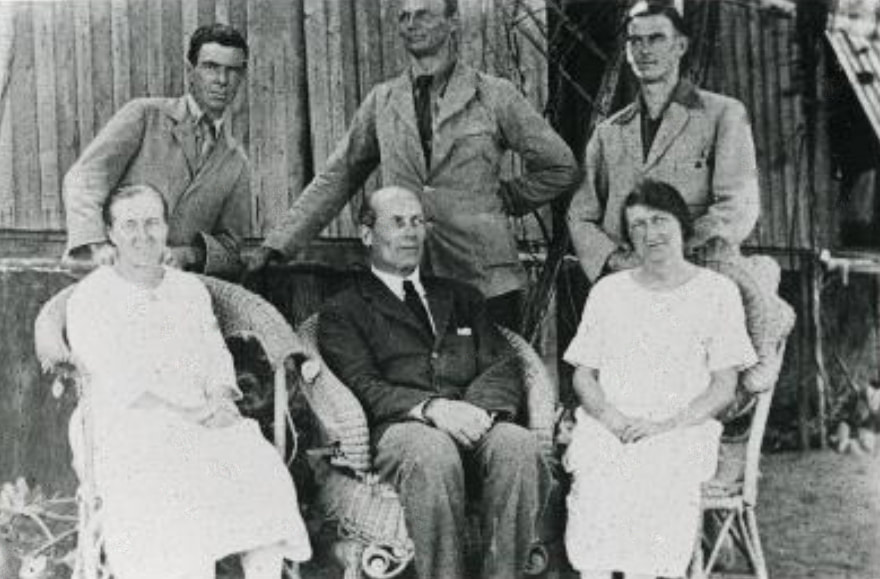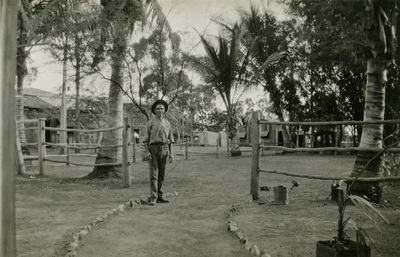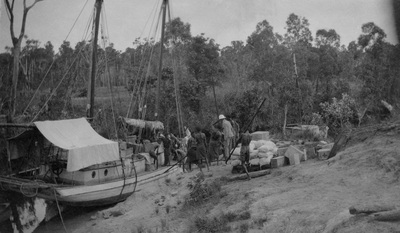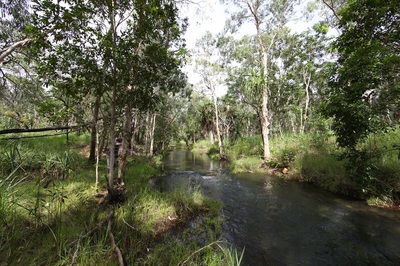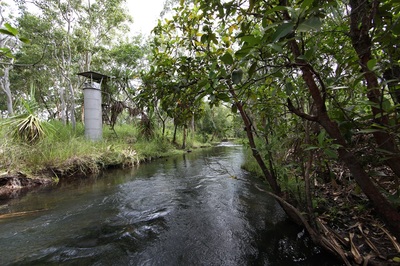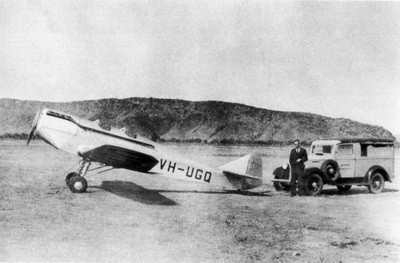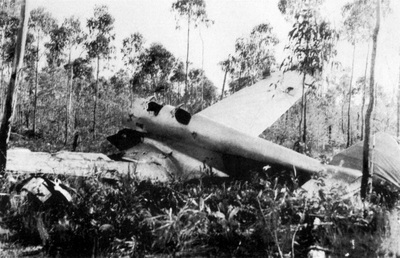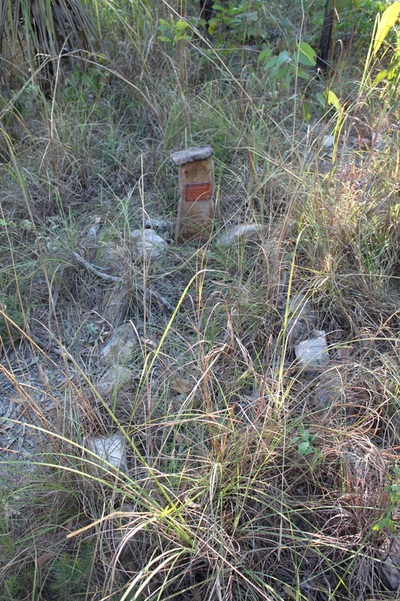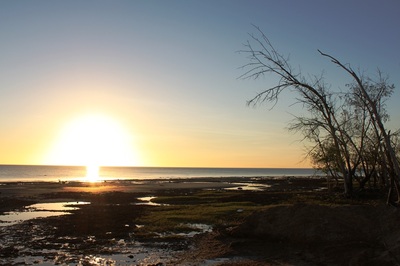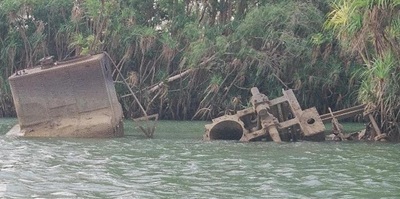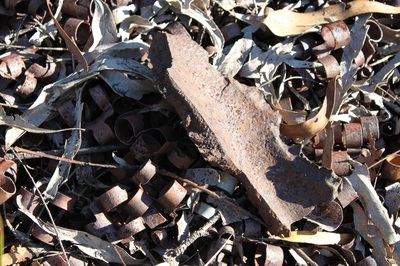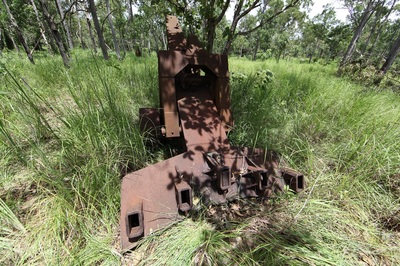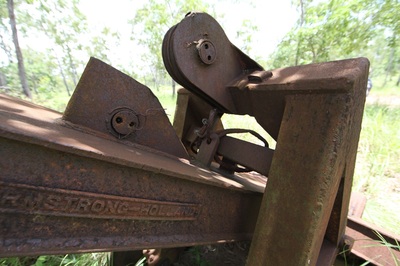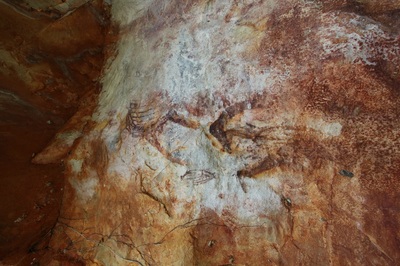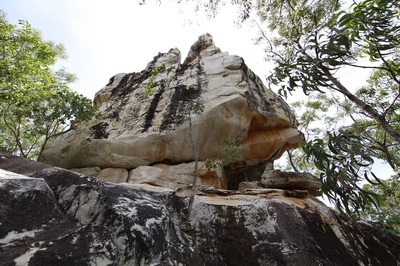Emerald River Mission
 Emerald River Mission
Emerald River Mission
Anglican Church Missionary Society CMS
At Roper River Mission (Ngukurr) the Rev. HE Warren was keen to expand operations northwards, including Groote Eylandt, despite the mission being devastated by flood in January 1916.
April 1916 - Rev HE Warren & Mr Rex Joynt & Yolngu sailed in the Evangel to Rose River (Numbulwar) then to Groote via Bickerton Island.
November 1916 - Warren returned & circumnavigated Groote for which he is recorded as an Australian Explorer.
September 1917 - Selected a mission site on Emerald River approx. 3kms from beach.
July 1918 - Bishop Henry Newton visit Roper R. – suggested separate mixed race (half-caste) mission be established on Groote Eylandt. Bishop Newton recommended to Government that an Arnhem Land Reserve be established including Groote Eylandt which, along with Oenpelli, was declared a Reserve in 1920 with the full Reserve gazetted in 1931.
1920 - The Holly, a 2nd hand lugger, purchased for the new mission to carry stores from Thursday Island. Ground cleared for the mission.
1921 - Malaria epidemic claims life of one of Warren’s children at Roper R. Master of Holly died of malaria.
1st August 1921 - Work began in earnest at Emerald R. – uncertainty whether to bring mixed race children over from Roper R. as after 2 years still no Groote women had been seen.
Easter 1923 - Emerald River mission destroyed by cyclone. Staff sheltered on only elevated house 2.7m but water rose above the floor level. All survived but everything destroyed. New site selected 9m above river level. Two years of preparing the ground & erecting buildings.
September 1924 - 16 mixed race girls arrived from Roper R. at new mission site a further 1 Km upstream – (4km from mouth of river). Miss Cross joined by their teacher Miss Dove. Instructed to make the work self-supporting asap - some formal schooling plus gardening, logging & carpentry.
October 1924 - 19 mixed race boys arrived from Roper River.
At Roper River Mission (Ngukurr) the Rev. HE Warren was keen to expand operations northwards, including Groote Eylandt, despite the mission being devastated by flood in January 1916.
April 1916 - Rev HE Warren & Mr Rex Joynt & Yolngu sailed in the Evangel to Rose River (Numbulwar) then to Groote via Bickerton Island.
November 1916 - Warren returned & circumnavigated Groote for which he is recorded as an Australian Explorer.
September 1917 - Selected a mission site on Emerald River approx. 3kms from beach.
July 1918 - Bishop Henry Newton visit Roper R. – suggested separate mixed race (half-caste) mission be established on Groote Eylandt. Bishop Newton recommended to Government that an Arnhem Land Reserve be established including Groote Eylandt which, along with Oenpelli, was declared a Reserve in 1920 with the full Reserve gazetted in 1931.
1920 - The Holly, a 2nd hand lugger, purchased for the new mission to carry stores from Thursday Island. Ground cleared for the mission.
1921 - Malaria epidemic claims life of one of Warren’s children at Roper R. Master of Holly died of malaria.
1st August 1921 - Work began in earnest at Emerald R. – uncertainty whether to bring mixed race children over from Roper R. as after 2 years still no Groote women had been seen.
Easter 1923 - Emerald River mission destroyed by cyclone. Staff sheltered on only elevated house 2.7m but water rose above the floor level. All survived but everything destroyed. New site selected 9m above river level. Two years of preparing the ground & erecting buildings.
September 1924 - 16 mixed race girls arrived from Roper R. at new mission site a further 1 Km upstream – (4km from mouth of river). Miss Cross joined by their teacher Miss Dove. Instructed to make the work self-supporting asap - some formal schooling plus gardening, logging & carpentry.
October 1924 - 19 mixed race boys arrived from Roper River.
1925 - Dr Cook Leprosy Survey found two young women to be infected – in theory they were to be isolated in a separate cottage as there was no treatment at that time. A further 6 cases diagnosed on next doctor’s visit in 1930. All cases managed in mission until Channel Island Leprosarium opened in 1931.
1933/34 - Caledon Bay Peace Mission - led by Warren. Following deaths of 5 Japanese crew of trepang lugger Kushimoto from the Aru Islands and two beachcombers Fegan & Traynor – Constable McColl was sent to apprehend the killers and was himself killed by Tuckiar. This saga had profound implications for Arnhem Land and Australian Aboriginals in general. It is explored in Ted Egan’s work Justice All their Own. Mention Donald Thomson.
1933-1943 - Although the Groote Eylandters had not been entirely neglected – after 1933 the mission devoted itself exclusively to their welfare. Some of those of mixed blood who had stayed on joined the mission workforce including Harold & Marjorie Hamilton and of course Fred & Gerry Blitner.
1933/34 - Caledon Bay Peace Mission - led by Warren. Following deaths of 5 Japanese crew of trepang lugger Kushimoto from the Aru Islands and two beachcombers Fegan & Traynor – Constable McColl was sent to apprehend the killers and was himself killed by Tuckiar. This saga had profound implications for Arnhem Land and Australian Aboriginals in general. It is explored in Ted Egan’s work Justice All their Own. Mention Donald Thomson.
1933-1943 - Although the Groote Eylandters had not been entirely neglected – after 1933 the mission devoted itself exclusively to their welfare. Some of those of mixed blood who had stayed on joined the mission workforce including Harold & Marjorie Hamilton and of course Fred & Gerry Blitner.
February 1942 - After the bombing of Darwin all European and half-caste women & children were evacuated south and the strip beside the mission was taken over by the RAAF. The CMS position is that the close proximity of “undesirable whites” to the mission prompted the move to Angurugu. In addition the RAAF paid far better wages and allowed the Aboriginal people far greater liberty than the Mission would countenance or could afford either financially or socially. The attention of Japanese aircraft, as indicated by large pieces of shrapnel, may have aided the decision making process. Once again sources are non-existent.
Today, Emerald River is a homeland (outstation) service from Angurugu which has a listed Heritage Precinct that contains several of the buildings that were relocated from Emerald River. Much of the agricultural machinery was likewise removed to the fertile gardens behind the community.
Today, Emerald River is a homeland (outstation) service from Angurugu which has a listed Heritage Precinct that contains several of the buildings that were relocated from Emerald River. Much of the agricultural machinery was likewise removed to the fertile gardens behind the community.
The Mission 1921 - 1943
World War Two
Caledon Bay Peace Mission 1933/34
HL Perriman
BOM
Pioneer Weatherman Reaches 100
No. 265 December 1983
A former Anglican missionary who provided rainfall reports to the Bureau from remote areas in the Northern Territory for 20 years recently celebrated his 100th birthday.
Mr H. L. Perriman, now living in Melbourne, went to Groote Eylandt in 1921 to establish the Emerald River Mission for the Victorian Church Missionary Society. He later worked at the Roper River and Oenpelli missions.
Before becoming a missionary he qualified as a mechanical and electrical engineer which was invaluable in his work at the isolated outposts.
DIR John Zillman wrote the following congratulatory letter to Mr Perriman on his becoming a centarian:
May I, on behalf of the Bureau of Meteorology, offer to you my heartiest congratulations. Your many years of devoted service have, and will continue to provide a source of inspiration to many people, and not only in your own field of endeavour. Your provision of rainfall reports to the Bureau during those early years in areas where meteorological information was scarce, was a valuable public service. Furthermore your detailed accounts of experiences in tropical cyclones are not only of great human interest, but are also a most useful supplement to our historical records of these great storms.
Kevin Murphy, ST02 in Darwin, who has been researching the history of tropical cyclones in the NT, has provided the following additional information on Mr Perriman:
In addition to providing rainfall readings to the Bureau from 1921-41, Mr Perriman gave detailed accounts of several tropical cyclones that he survived, including two amazing experiences in 1923 and 1940. On Good Friday 1923, he and Mr Lousada plus several aborigines prayed through a terrifying night as the Douglas Mawson cyclone and a 6˝ metre storm surge demolished their two-storey mission building. This is generally considered to be the highest reliably confirmed storm surge in Australia. In January 1940 a cyclone and prodigious flood swelled the mighty Roper River by 25 metres. As their mission disappeared under the floodwaters, Perriman and the other mission folk took refuge in the lugger the 'Holly'. The raging torrent however dragged the boat under the water and the occupants were forced into the branches of a large coolibah tree. Here they spent the remainder of the night expecting at any moment to be swept away to their doom.
Mr Perriman's recollections of his years in the Territory have been preserved in books, photos, articles and cassette recordings donated to the NT Historical Society.
Pioneer Weatherman Reaches 100
No. 265 December 1983
A former Anglican missionary who provided rainfall reports to the Bureau from remote areas in the Northern Territory for 20 years recently celebrated his 100th birthday.
Mr H. L. Perriman, now living in Melbourne, went to Groote Eylandt in 1921 to establish the Emerald River Mission for the Victorian Church Missionary Society. He later worked at the Roper River and Oenpelli missions.
Before becoming a missionary he qualified as a mechanical and electrical engineer which was invaluable in his work at the isolated outposts.
DIR John Zillman wrote the following congratulatory letter to Mr Perriman on his becoming a centarian:
May I, on behalf of the Bureau of Meteorology, offer to you my heartiest congratulations. Your many years of devoted service have, and will continue to provide a source of inspiration to many people, and not only in your own field of endeavour. Your provision of rainfall reports to the Bureau during those early years in areas where meteorological information was scarce, was a valuable public service. Furthermore your detailed accounts of experiences in tropical cyclones are not only of great human interest, but are also a most useful supplement to our historical records of these great storms.
Kevin Murphy, ST02 in Darwin, who has been researching the history of tropical cyclones in the NT, has provided the following additional information on Mr Perriman:
In addition to providing rainfall readings to the Bureau from 1921-41, Mr Perriman gave detailed accounts of several tropical cyclones that he survived, including two amazing experiences in 1923 and 1940. On Good Friday 1923, he and Mr Lousada plus several aborigines prayed through a terrifying night as the Douglas Mawson cyclone and a 6˝ metre storm surge demolished their two-storey mission building. This is generally considered to be the highest reliably confirmed storm surge in Australia. In January 1940 a cyclone and prodigious flood swelled the mighty Roper River by 25 metres. As their mission disappeared under the floodwaters, Perriman and the other mission folk took refuge in the lugger the 'Holly'. The raging torrent however dragged the boat under the water and the occupants were forced into the branches of a large coolibah tree. Here they spent the remainder of the night expecting at any moment to be swept away to their doom.
Mr Perriman's recollections of his years in the Territory have been preserved in books, photos, articles and cassette recordings donated to the NT Historical Society.
Resources & Related Articles
|
| ||||||||||||
Keith Cole is the major source of CMS history - naturally there is some bias - he was at times under impossible pressure. He is hyper-defensive of the missionaries because when Government took over the communities it systematically denigrated mission achievements - e.g. when the new pasture grass provided by the Government proved to be a rampant pest it was renamed Mission Grass. The Missions may have had the best of things in respect of the size of the population; the people's ability to go bush and feed themselves at least in a supplementary way and the lack of external influence before air transport, roads, 4wd vehicles, radio, television and the coup de gras - the mobile phone. Cole - as with all Mission commentary - carefully avoids un-pleasantries such as violence and the reasons for separating young 'half-caste' {aka of mixed blood, Indigenous} people from 'full-blood' Aboriginal people. In those times it would not have been necessary to explain & today all terms are pejorative - neither is the situation necessarily clarified by the significant number of 'full-blood' Arnhem Land people with straight hair.
Keith Cole:
Groote Eylandt - Changing Aboriginal Lifestyles 1983
Groote Eylandt Pioneer - biography of HE Warren 1971
Groote Eylandt Stories - 1972
Perriman in Arnhem Land - biography of HL Perriman 1973
John Harris:
We wish we'd done more - 1998
Ellen Kettle:
Health Services in the NT - a History 1824-1970 vol 1. 1991
Lots of images & background as to the burden of disease that is otherwise only glimpsed from the mission day books & station reports - also many interesting asides - e.g. 1st case of leprosy diagnosed in an Australian Aboriginal was at Elsey Station in 1890.
Keith Cole:
Groote Eylandt - Changing Aboriginal Lifestyles 1983
Groote Eylandt Pioneer - biography of HE Warren 1971
Groote Eylandt Stories - 1972
Perriman in Arnhem Land - biography of HL Perriman 1973
John Harris:
We wish we'd done more - 1998
Ellen Kettle:
Health Services in the NT - a History 1824-1970 vol 1. 1991
Lots of images & background as to the burden of disease that is otherwise only glimpsed from the mission day books & station reports - also many interesting asides - e.g. 1st case of leprosy diagnosed in an Australian Aboriginal was at Elsey Station in 1890.



